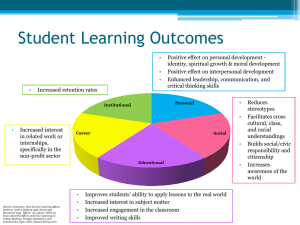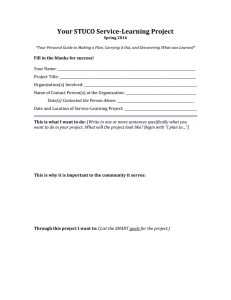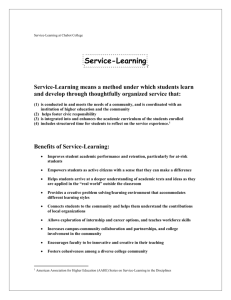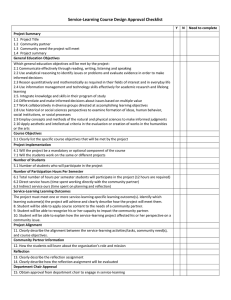SL Institute Kick off 2
advertisement
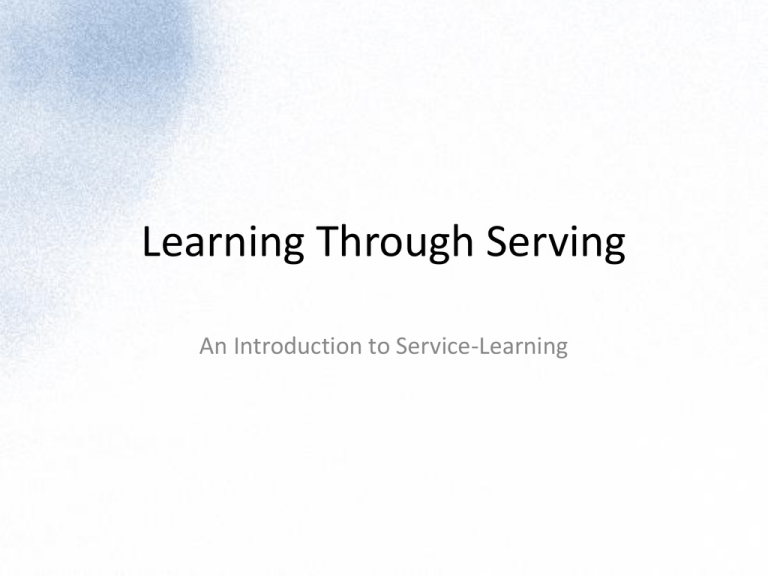
Learning Through Serving An Introduction to Service-Learning Introductions • Your name • Your discipline • How long you’ve been at SDSU • Discuss the following questions: – What draws you to explore this pedagogy? – How do you think SL will affect student learning? – How do you envision your role changing, if at all? Definition What is service-learning? • Service-learning combines meaningful service in the community with a formal educational curriculum and structured time for participants to reflect on their service and educational experience. Service-learning stands in contrast to traditional volunteering or community service, which generally does not include reflection or links to any organized curriculum. (Hollis, 2004, p. 576) Another Definition Service-learning is a “course-based, creditbearing educational experience in which students a) participate in an organized service activity that meets identified community needs and b) reflect on the service activity in such a way as to gain further understanding of course content, a broader appreciation of the discipline, and an enhanced sense of civic responsibility.” Bringle & Hatcher, p. 83 in Toolkit Essential Elements • Learning and service objectives are clearly identified and compatible • Service is meaningful, challenging, and meets a real need • Fosters learning about larger social issues • Reflection is continuous, structured, and complex Types of Service • Direct • Indirect – Advocacy – Research – Capacity Building Service Projects • • • • One-time group projects Cross-disciplinary projects Multi-semester projects Immersion experiences – Alternative Weekend – Alternative Breaks Asset-Based vs. Need-Based • Intending to “fix” and “help” can drive community groups to feel marginalized and disengage • “Development” orientation encourages discovery of community assets and devising ways to build upon them Needs vs. Assets Needs Assets Focuses on deficiencies Focuses on effectiveness Results in fragmentation of responses to local needs Builds interdependencies Makes people consumers of services; builds dependencies Identifies ways that people can give of their talents Residents have little voice in deciding how to address local concerns Seeks to empower people Partnership • Common plan • Resource sharing • Investment of time together – Closeness determined by • Frequency of interaction • Diversity of interaction • Strength of interdependency The Power of Partnerships • Establish missing but critical connections • Identify new/better way to solve problems • Link complementary skills and resources of diverse people and organizations • Plan and carry out comprehensive actions that coordinate reinforcing strategies and systems Campus-Community Partnerships • A series of interpersonal relationships between – Campus administrators, faculty, staff, and students – Community leaders, agency personnel, and members of community • To leverage resources to address critical issues in local community Service-Learning Partnership • Faculty member and agency representative articulate – Educational and community needs – Roles and expectations – Communication plan – Time line – Evaluation process – What success will look like Service-Learning Partnership • Faculty shares syllabus and learning objectives • Community partner provides matching service activity, orientation, and supervision • Partners communicate throughout and make adjustments if service or learning needs aren’t being met • Conclude by celebrating accomplishments and evaluating results Things to Consider • • • • • How do the students benefit academically from the project? Is there a balance between the agency’s needs and students’ abilities? Have you assessed the length of the project? Are the service projects designed to fit students’ class and semester schedules? Is staff available to provide supervision and evaluation? Something to avoid… Student shows up at agency and says: “I need X hours for my class. Can I get them this week?” What’s wrong with this scene? • Learning objectives – What will student learn in X hours? – Can this be learned at this agency? • Service objectives – What are the agency’s needs? – Can the student be effective without training and orientation? • Where is the partnership? Benefits to Students • Personal – enhanced sense of efficacy, identity, morality, leadership • Social – diversity, social responsibility, citizenship skills, commitment to service • Academic – increased complexity of understanding, problem analysis, critical thinking, GPA, cognitive development, ability to apply learning to “real world” Benefits to Faculty • Enrich and enliven teaching • Identify new areas for research and publication • Develop projects that are simultaneously productive in research, service, and teaching • More efficient use of available resources • Foster cross-disciplinary learning communities Benefits to Agencies • • • • Infusion of people power to meet needs Voice in education of next generation More informed/involved citizenry Build networks with others active in community development • Foster potential future donors and volunteers • New ideas, energy, and technical assistance • Gain perspective of outsiders; 3rd party evaluations Benefits to Institution • Enhance student satisfaction, retention, and graduation rates • Improve relationships with community • Advance institutional goals – Social Responsibility – Scholarship of Teaching and Learning – Diversity Enhancement • Promote coherent collaborative curriculum TLC Development of Community Partners • Discover needs of active service groups on campus and in the community • Attempt to connect faculty with potential partners to foster a relationship between them • Identify new organizations to add to a partner list encompassing more than 40 members TLC Approach to Developing Partners • Identify active service organizations • Identify perceived needs and then investigate their validity • Soliciting recommendations from current partners on new potential partners • Maintain an open dialogue with Faculty to discover what they recognize as needs Assessment • Key to establish learning outcomes related to integration of content and service-learning experience. Can be done by combining traditional classroom assessment with servicelearning project assessments. – Presentations – Papers – Portfolios Critical Reflection • Is an essential process for transforming experiences into genuine learning • Requires students to analyze concepts, evaluate experiences, and form opinions • Promotes higher-level thinking, problem-solving, selfawareness, and the habit of questioning • Challenges students to combine facts, ideas, and experiences to derive new meaning • Enables students to become knowledge producers, not just consumers • Generates, deepens, and documents learning Critical Reflection • • • • • Links experience to course learning objectives Is guided and purposeful Challenges assumptions and complacency Occurs before, during, and after service Includes components that can be evaluated according to well-defined criteria • Involve reading, writing, doing and telling • Clarifies values and fosters civic responsibility Reflecting Before Service • Helps students – understand community needs and organization – consider different perspectives – prepare to work with diverse population – examine own beliefs, assumptions, attitudes – establish baseline to measure change and growth at end of project Reflecting During Service • Provides a means for instructor to – assess student progress toward goals – ensure that students are performing tasks competently – offer feedback, helping students to refine and develop ideas – determine developmental level of student – seize teachable moments – reinforce connection with course content Reflecting After Service • Helps students to – – – – evaluate the meaning of their experience connect service back to disciplinary knowledge explore future applications acknowledge personal growth • Enables instructor to challenge students to – – – – engage in critical thinking practice public problem-solving consider responsible application of knowledge evaluate impact of service Student Dissemination of Experience • Service-Learning Showcase • Undergraduate Research Opportunities • Conferences
